2004 VOLKSWAGEN GOLF fuel
[x] Cancel search: fuelPage 311 of 444
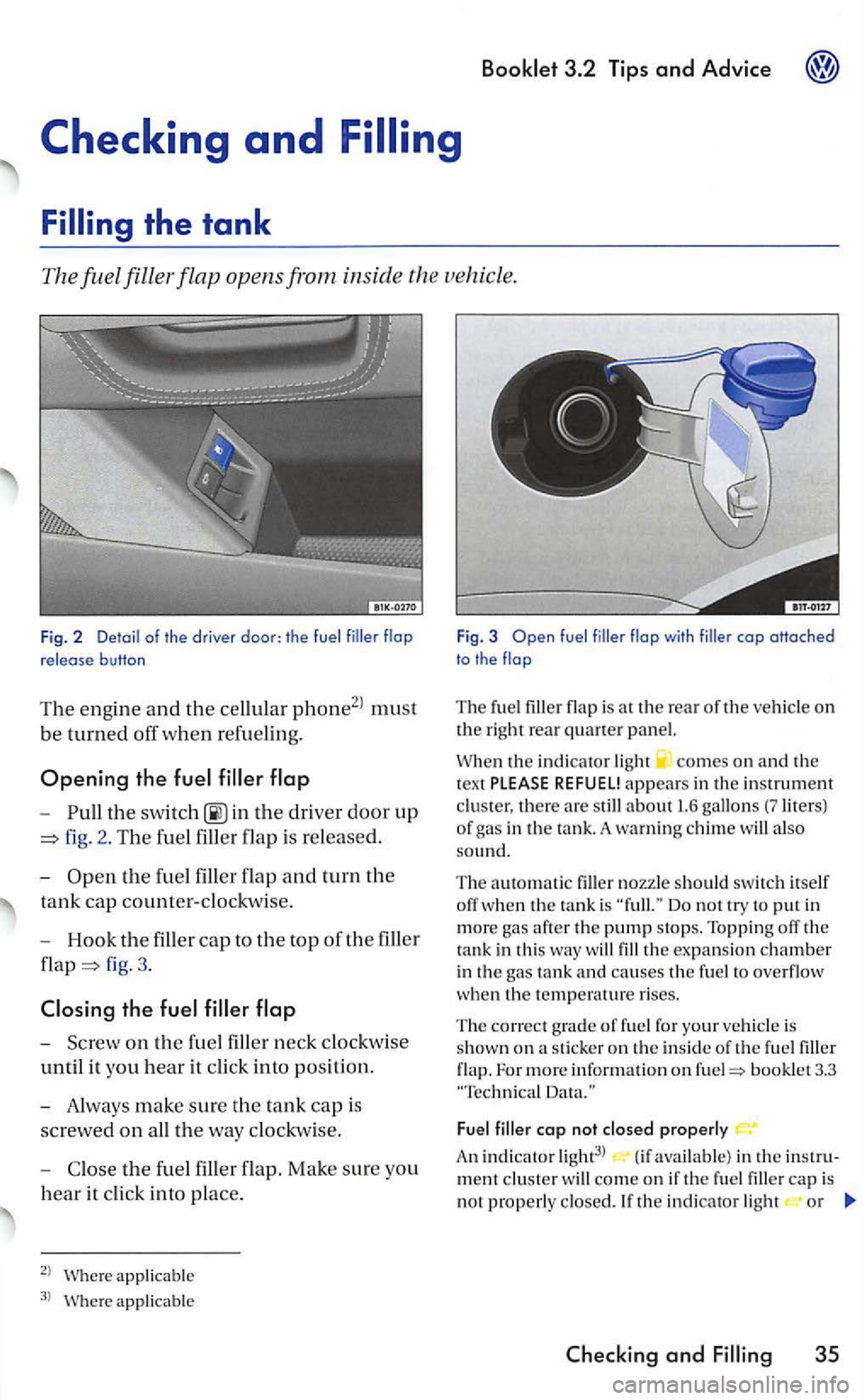
-in the driver door up
fig. 2. T he fuel filler flap is re leased.
-
Open t h e f uel filler flap and turn the
tank cap counter-clockwise.
- Hook
the fille r cap to the top of th e filler
fig. 3.
the
-Screw o n the
applicable
applic able
Fig . 3 fue l flop with cop oHoched
to the
The fu el flap is a t the rear of the vehicle on the right rear quarter panel.
th e indi cator light comes on and th e
t ex t PLEASE REFUEL! appears in the in strume n t
clu ster, there are s till ab out 1.6 gallo ns (?liters) of g as in the tank. A warning ch im e will also so und.
The automatic nozzle shoul d swi tc h itself off w hen the ta nk is
the expansion chamber
i n the gas ta nk and causes the fuel to overflo w when the temperature rises.
T
he correct g rade of fu el for your vehicle is
show n on a stick er o n th e inside of the fu el flap. For m ore informatio n on bookle t 3.3
Fuel filler cop not closed prope rl y
A n in d ic a to r light3l (if available) in the
Checkin g and 35
Page 312 of 444
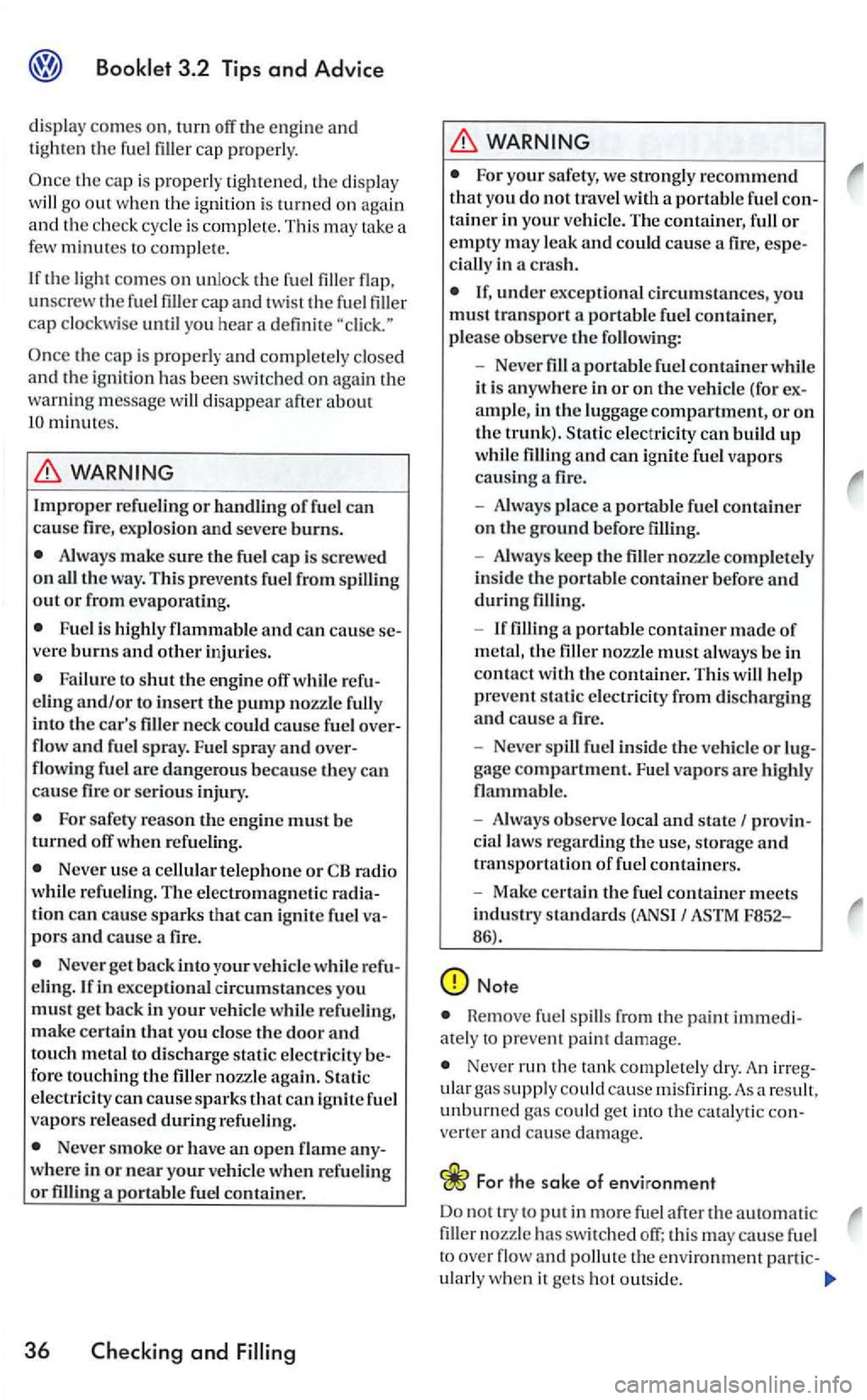
Booklet 3.2 Tips and Advice
display come s on, turn off the engine and
t ig ht en th e fuel filler cap prop erly.
the cap is prop erly and comple te ly closed
a nd the ig nition has been switc h ed on agai n th e
wa rning message will disappear after abo ut
Improper refueling or handling of fuel can
cause fire, e xplosion and severe burns.
Always make sure the fuel cap is sc rewed
o n
Fuel is hi ghly flammable and can cause
eling and/or to insert the pump nozzle fully
into the filler neck could cause fuel flow and fuel s pray. Fuel spray and flowing fuel are dangerou s beca use they can cause fire or serious injury.
For safe ty reason engine must be turned off when refueling .
Never use a ce llular te lephon e or radio w hile refueling. The electrom ag ne ti c tion can caus e sp arks that can ig nite fuel pors and cause a fire .
Never get back into your ve hicl e while eling. If in exceptional circumstances you must ge t back in your vehicl e while refu eling, make ce rtain that you close door and touch metal to di scharge stati c electricity for e tou chin g the filler nozzle again. electricity can cause sparks can ignit e fuel
vapors released during refuelin g.
Never smoke or h ave an open flame where in or near you r vehicle when refu elin g or fillin g a portable fuel container.
36
For your safety, we strongl y recommend that you do not travel with a portable fuel
cially in cras h.
If , under exceptional circum stances, you must transport a portable fuel co ntain er,
pl ease observe the foUowing:
- Never
fill a portable fuel container while
it is anywhere in or on the ve hicl e (for ampl e, in the lu ggage compartment, or on the trunk). electricity can build up while filling and can ig nite fuel vapors
ca usin g a fire.
- Always pl
ace a portabl e fuel container on ground b efor e
-Alway s keep the filler nozz le co mplet ely
in side the portab le container b efo re and during fillin g.
- If filling a
portable container made of
metal , the filler nozzle must a lway s be in
contact with the container. This will help prevent static e lec tricity from disc ha rgin g and ca use a fire.
- Never
cial laws regarding the use, storage and transporta tion of fuel containers .
- Make certain
the fuel container meets
industry standa rd s F852-86).
Remove fu e l spills f rom the paint ately to prevent pai nt dam age.
Never run the tank completel y dry. An ular gas supply co uld cause misfiring. A s res ult ,
u n burn ed ga s co uld get into the ca ta lytic vener a nd cause damage .
For the sake of environm ent
Do no t try to p ut in more fuel after the au to m atic fille r no zzle has switched off; this may ca use fuel to over flow and pollut e th e enviro nment parti c-
ularl y when it ge ts hot outside.
Page 313 of 444
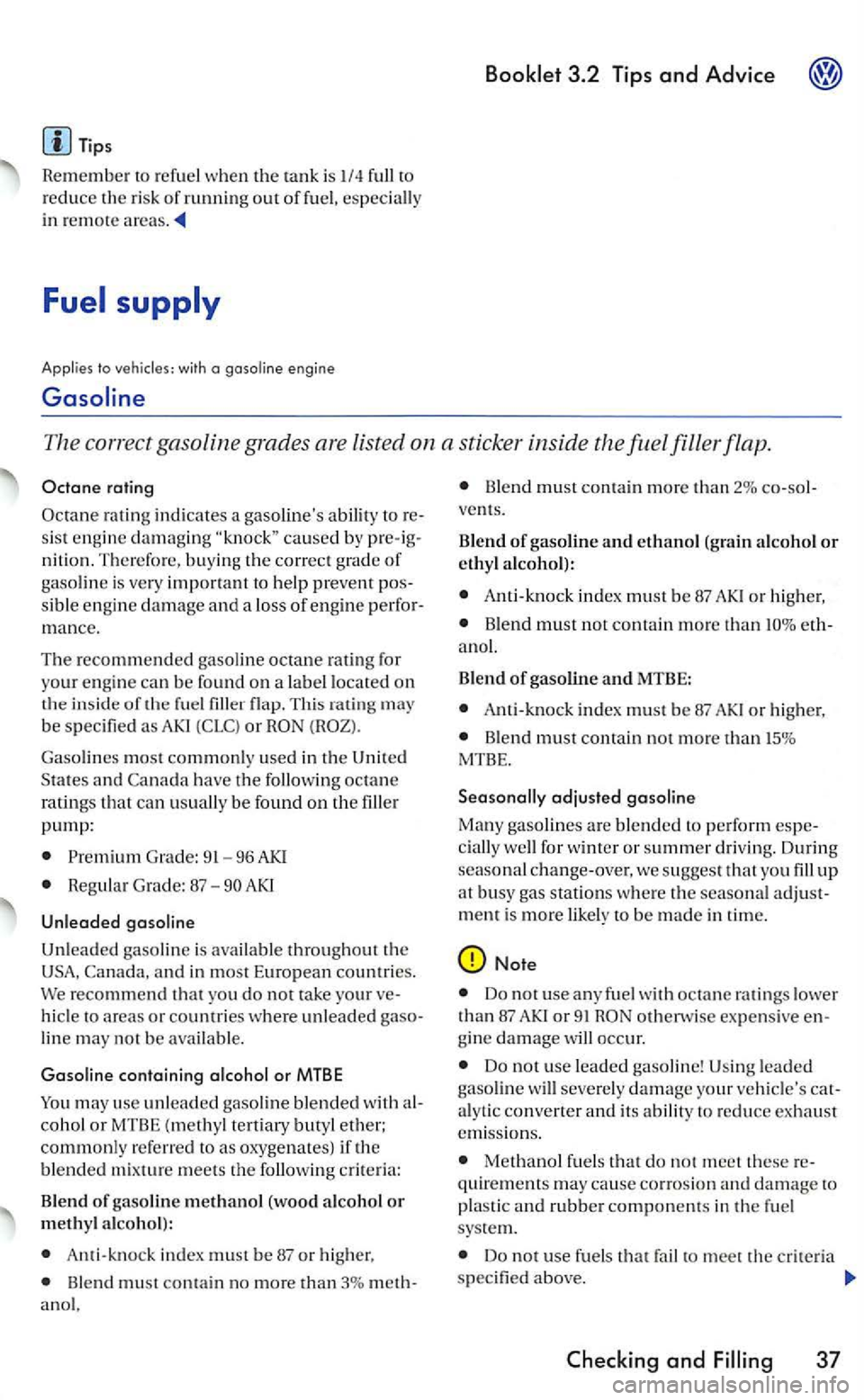
Tips
Remember to refuel w hen the tank is 1/4 full to reduce the risk of running out of fuel, es pecially in remote areas.
Applies to vehicles: with a gas oline engine
The correct gasoline grades are listed on a sticker inside the fuel filler flap.
rating
Oc tane caused by pre-i g
n it ion . Th ere fore, buying th e correct grade of gasoline is very important to help prevent possibl e engine damage and a loss of engine performance.
The recommended gasoline octane ra ting for
your e n g in e can be found on a label lo cated on the in sid e o f the fuel flap. This ratin g m ay be specified as (CLC) or
Grade: 91-96 AKI
Regular Grade: 87-90
Canada, a nd in most European countries.
We recommend that you do not take your ve
hicl e to areas or countries where unleaded gasoline may not be available.
Gasoline containing alcohol or MTBE
You may us e unleaded gasoline blended withalcohol or MTBE (methyl tertiary butyl ether; commonly re fe rr ed to as oxygenates) if the
b lende d mi xture meets th e following criteria:
B
lend of gasoline methanol (wood alcoho l or methyl a lcohol):
A nti -knoc k ind ex must be 87 or higher,
methanol.
An ti-k nock index must b e 87 or higher,
Blend must not contain mor e t ha n ethanol.
Blend of gasoline and MTBE:
Anti-knock ind ex must be 87 or high er,
Blend must conta in not more than 15%
MTBE .
Seasonally adjusted gasoline
Many gasolines are blended t o perform especially well for winter or summe r driv in g. During
seasonal change -over, we sugges t th at you fill up
at busy gas stations where th e seasonal adjustment is more like ly to be made in time.
Note
Do not use a ny fu el with octane lower than 87 or 91
Do not use leaded gasoline! U sin g leaded gasoline will seve re ly damage your vehicle's catalyt ic conver te r and its ab ility to reduce exhaust emissions.
Methanol fuels that do not meet these re quirements may cause corrosion and damage to plast ic and rubbe r component s in the fuel
sys tem.
Do not use fuels that fail to meet the c rit eria specified above .
and 37
Page 314 of 444
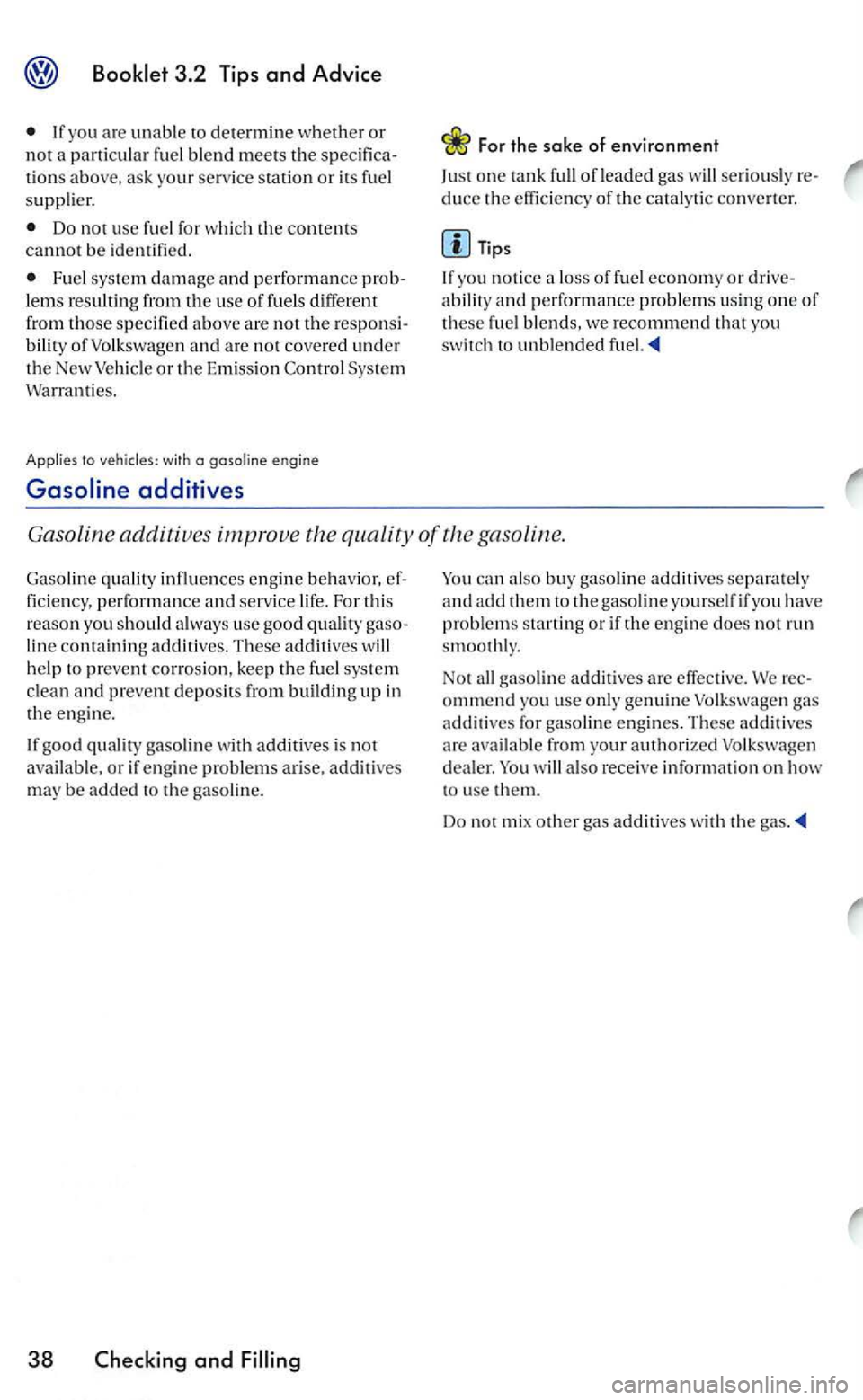
you are unable to determine whether or not a particular fuel blend meets the tions above, ask your service station or its fu el
s uppli er.
Do not use fuel for which the contents cannot be identifi ed.
F uel syste m damage and performance lems result ing from the use of fu els different
from those specified above are not the b ili ty of Volkswagen and are not covered under the New Vehicle or the Emi ssio n
Fo r the sake of environment
Just one tank f ull of leaded gas will seriou sly duce th e efficiency of the catalytic co nve rter.
you notice a lo ss of fuel economy or ability and performance problems using one of these fuel blends, we recommend th a t yo u
switc h to unblended
Gasoline additives improve the quality of the gasoline.
Gasolin e qualit y influences engine behavior, ficie ncy, performance and service life. For this
reason you should always use good quality line containin g additives. These additi ves will
h elp to prev ent corrosion, keep the fuel system clean and pre vent deposit s from building up in
the engine.
good quality gasolin e with additives is not availab le, or if eng in e probl em s arise, additives may be added to the gaso lin e.
38 Checking and
will also receive information on t o use them.
Do
Page 329 of 444
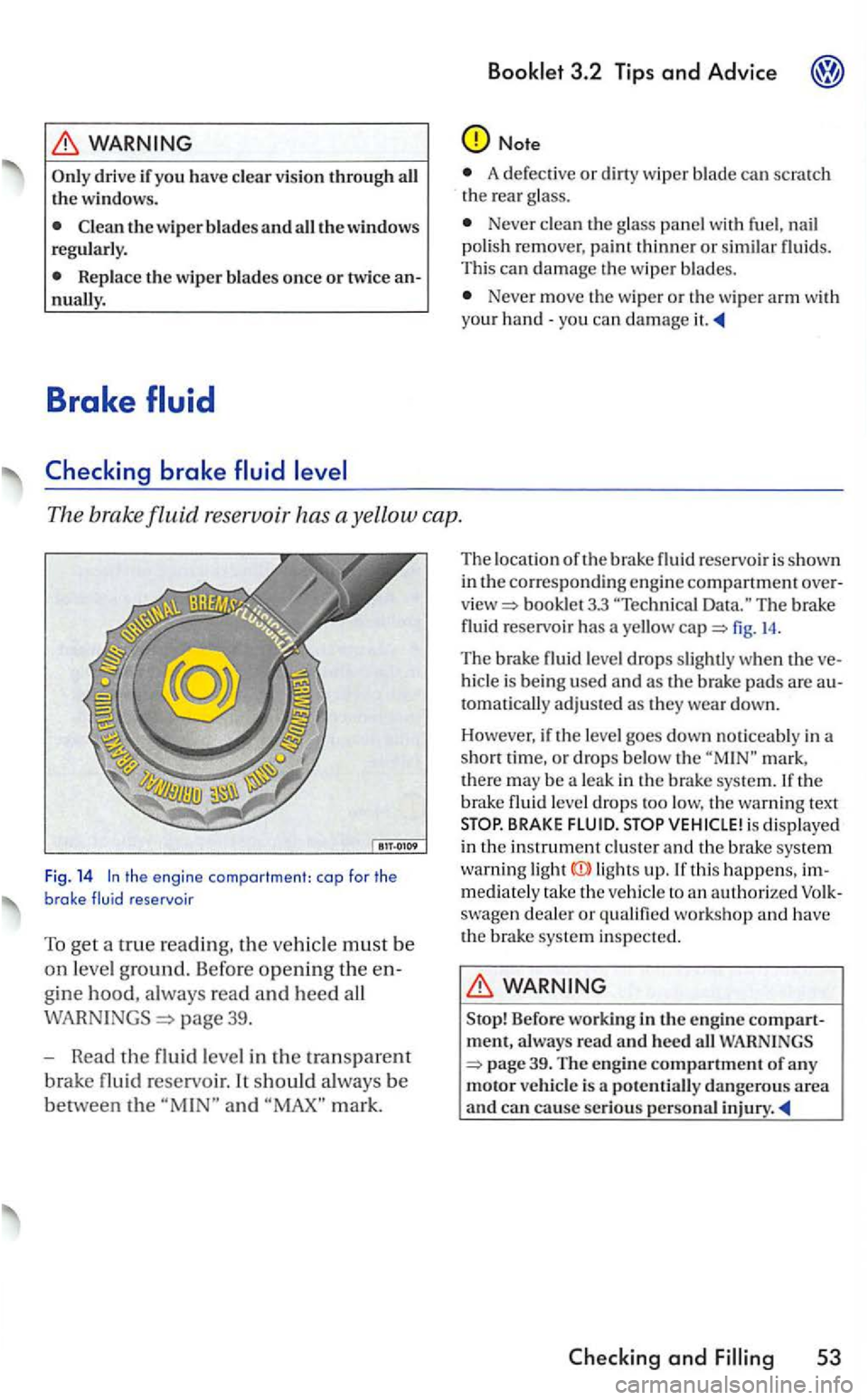
drive if you have clear vis io n through all the windows.
A defect ive or d irt y w iper blade can scratch
t h e rear glass.
Never clean gla ss panel with fuel. nail polish remove r, p aint thinn er o r similar flu ids.
Thi s ca n damage th e w iper bla d es.
Never move the w iper or the wiper arm your hand can dam age it.
The brak e fluid reservoir has a ye llow cap.
Fig. 14 the engine compartment: cap for the brake fluid reservoir
To get a true reading, the m ust b e
on leve l ground. Before opening th e en
g
ine hood, a lways read and heed all
page 39.
- Read
the fluid leve l in the tra nsparent
bra ke fluid re servoir. It should always be
between the and mark.
Th e lo cation of th e brake fluid reservoi r is shown
in
bookl et 3.3 The brake
fluid reservoir has a yello w fig. 14 .
The brake fluid lev el drops s lightl y when th e ve
hicl e is bein g used and a s th e brake pad s are autom atically adju sted a s they wear down.
Ho wev
er, if th e le ve l goes down noticeably in a
s ho rt time, or drops below th e mark ,
th ere may be a leak in the brake system. If the b rake fluid leve l d rops too low, the wa rnin g text BRAKE FLUID. is displayed
in the instrument clu ste r and th e b rake system warni ng ligh ts up. If t his happens, immediately rake th e ve hicle to an au thorize d swage n deale r or q ualifi ed wo rkshop a nd have
th e brake system inspected.
Stop! Before wo rkin g in th e engin e compartment, a lways read and heed all WARNINGS
53
Page 338 of 444
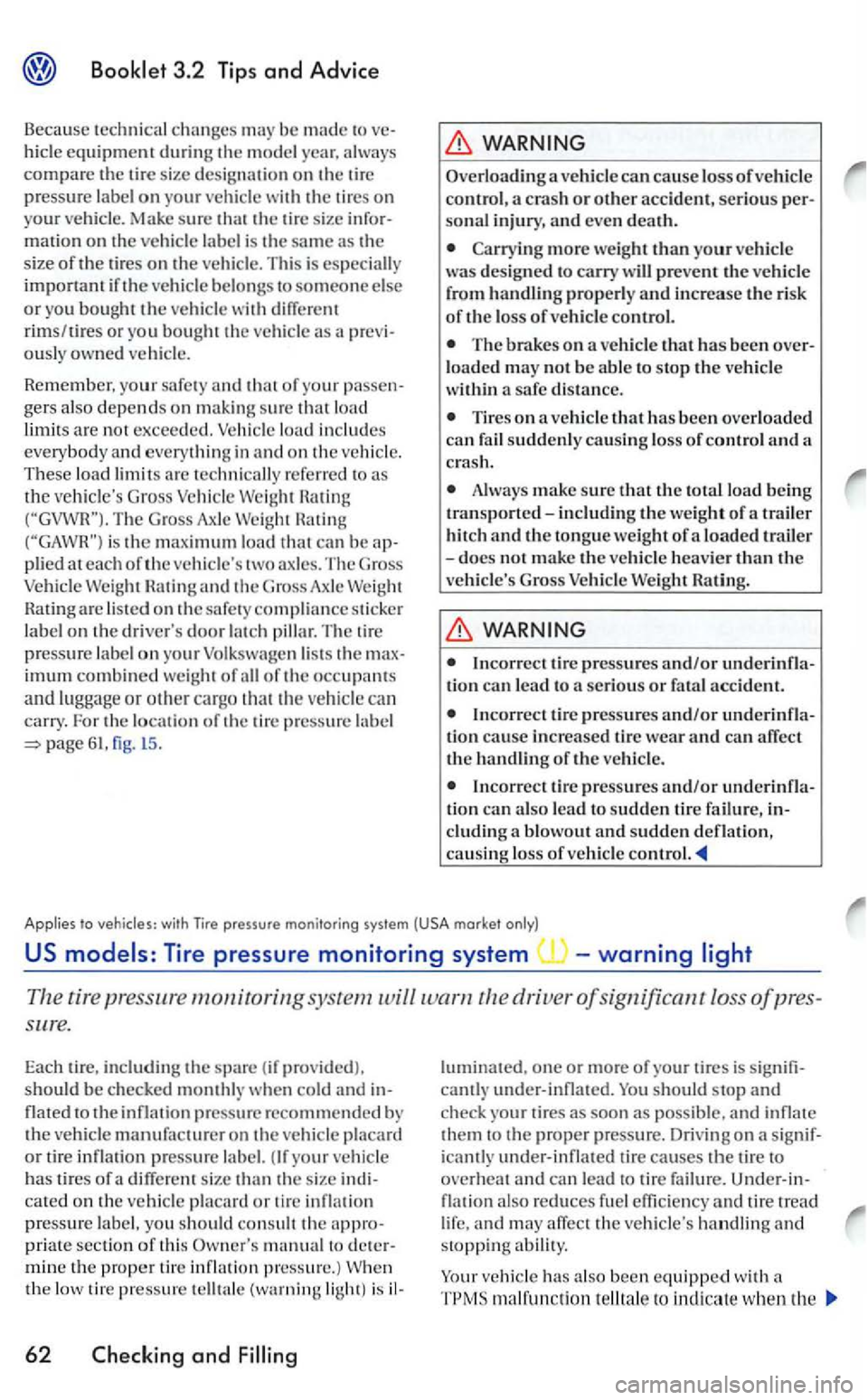
3.2 Tips and Advice
Because technical changes may be made to vehicle equipment during the model year, always compare the tire size desig nation on the tir e pressure label on your vehicle with the tire s on your vehicle. Make sure
a previousl y owned ve hicle.
Remember, your safe ty and t h at of your passengers also depends on making sure that load
limit s are not exceeded. Vehicle load includes everybody and everything in and on the vehicle.
T hese load limit s arc techni call y referred to the ve hicle's Gross Vehicl e Rating Hatin g is th e maximum load that
Hating are listed on th e s afet y compliance sticker
label on t h e driver's door
fig. l5 .
WARNING
Overloading a vehicl e can cause loss of vehicle control,
more we ight than your vehicle was des ign ed to carry w ill prevent the vehicle from handling properly and increase the risk of the loss of vehicle control.
The on a vehicle that has been over
loaded may not be abl e to stop the vehicle within a safe distance.
Tires on a vehicle that has been overloaded can fail suddenly cau sin g loss of control and a crash.
Always make sure that the total load being transp o rted-including the weight of a trailer hitch and the to ng u e weight of a loaded trailer -docs not make the vehicle heavie r than the vehicle's Gross Vehicle
WARNING
Inco rrect tire pressures and/or underinflation can lead t o serious or fata l accident.
Incorrect tire pressures and/or underinflation cause increased tire wear and can affect the ha nd lin g of the ve hicle.
Applies to
The tire pressur e monitoring syste m driver ofsignificantloss of pres
sure.
Each tire, including the spare ( if provided),
should be c heck ed
your vehicle has tire s of a diff erent s ize than the s ize indi cated on the vehicle placard or tire inflation pressure lab el, you should consult the appropriate sec tion of this
and
luminatcd. one or m ore of your tires is signifi
cantly under-inflated. should stop and check your tires as soon as possible , and inflate them to the pro p er p ressure. Driving on a sig nif
icantly under- inflated tire causes the tire to overheat and can lead to tire failure. Under- in-
flation al so reduces fuel effic iency and tire tread life , and may affe ct th e vehic le's handling stopping ability.
ve hicle has also been equipped with a malfunction te llt ale to indi cate when
Page 343 of 444
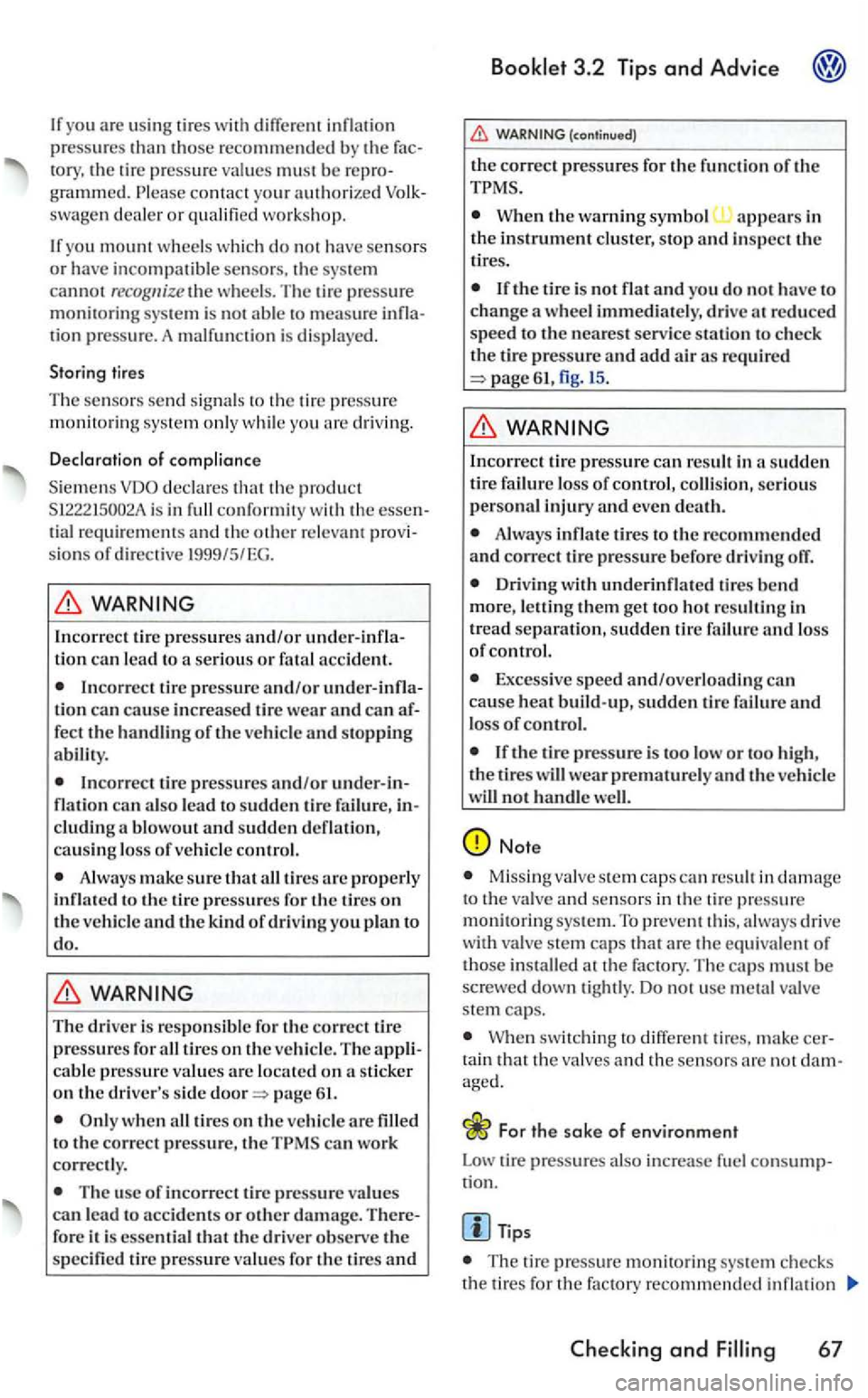
you are using tires w ith inflatio n
p ressures than those recommended by the tory, the tir e press ure val ues must be re programmed. swagen dealer or q ualified workshop.
you mount wheels whic h d o not have sen sors or have incompatible sensors . th e sys tem cannot recognize the wheel s. The tir e pressure monitoring sys te m is not abl e to measure infla
tion press ure. A malfun ction is di sp la ye d.
S t
oring tires
T he se nsors se nd signa ls to t h e tir e press ure
monitori ng sys te m only whi le you arc driv ing .
D eclaration of complianc e
Siemens declares that the product is in full c onfo rmit y w ith the essential requi rements and the other re levant prov i
sio ns of directi ve 19 99/5/EG.
WARNING
In correc t tire pressures and/or unde r- inflati o n can lead t o
an d can
Incorrect t ire p ressures and/o r under-i n
flatio n ca n also lead to sudden tir e failure, bl owout and sudden d eflati on, causing loss of ve hicl e control.
Always make sure that a ll tires are properl y
inflat ed t o tire press ures fo r th e tires o n
t h e vehicl e and the kind of driv in g yo u plan to
do.
WARNING
The d rive r is responsib le for the correct tire
press ures for all tires on th e ve hicle. The cable pressure values arc loc ate d on sticke r
o n the dri ver's sid e page 61.
correctly.
The use of in correct tire pressure values can lead to acci den ts or other damage. There
f o re it i s esse ntial that the d river observe the
s p ecified tire p ressure va lues fo r the tires an d
Booklet 3.2 Tips and Advice
WARNI NG (continued)
the correc t pressures fo r the functi on of the
W hen the
the ti re is not flat and you do no t have to
c h an ge a w heel immed ia tely, drive
required fig. 15.
WARNING
Incorrect tire pressure can result in sudde n
t ire failur e loss of control, co llisio n, seri ous
personal i njury an d even death.
A lways in flat e tires to the recommended and correct tire pressure before dri ving
D rivi ng with unde rinfl atc d ti res b end m ore, le ttin g them get too h o t res ulting in tread sep aration, sudden tire failure and loss
o f co ntrol .
Exces sive speed and/ overloading can cause heat build-up , sudden tire fa ilure a nd
l oss of control.
not handl e we ll.
Missin g valve ste m caps can resu lt in damage to th e va lve and sensor s in the tire pressure mon itorin g sys te m. To pre vent t his, alwa ys dri ve
with valve stem caps that are the equi valent of th ose insta lled va lve
s te m caps.
Whe n switc hin g to t a in that the va lve s and the sensors not aged.
For the sake of environment
Low tire pressures also increase fuel consump
tion.
The tire pressu re monitoring syste m checks
th e tires for the fac tory recommend ed inflation
Page 368 of 444
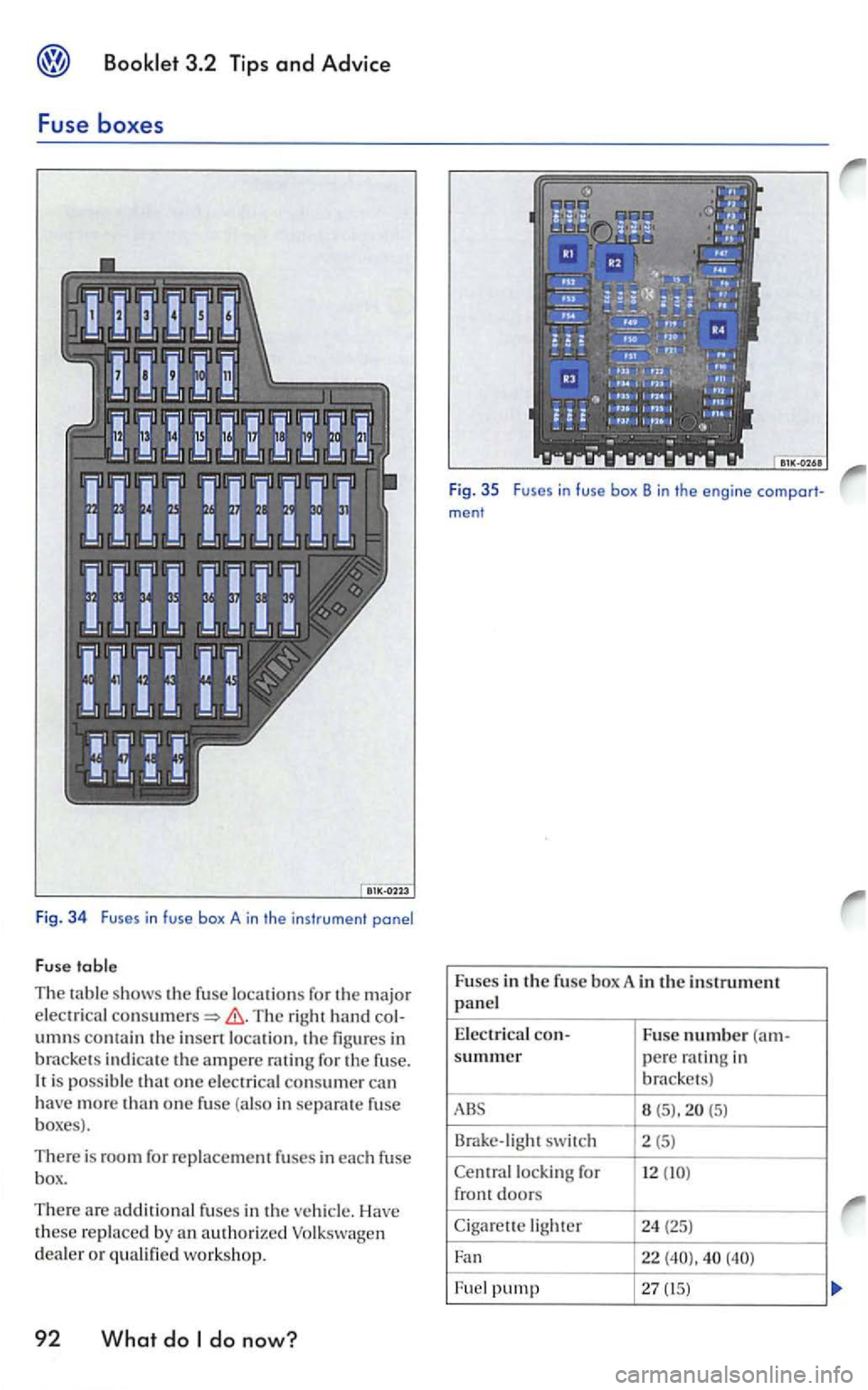
Fig . 34 Fuses in fuse box A in the instrument panel
F
use table
The s h ows the fuse locations for th e major
elec trical hand columns comainth e location , th e the ampere for the fu se. is po ssible that one electr ical con sumer can
have more tha n one fuse (a lso in separate fuse boxes ).
There is room for replacement fuses in each fuse
box.
There are additiona l fuses in the Have these rep laced by an authorized
brac kets)
8 (5), (5)
Brake -light switch 2 (5) -Cen tral for 12
-Fuel pump 27 (15)